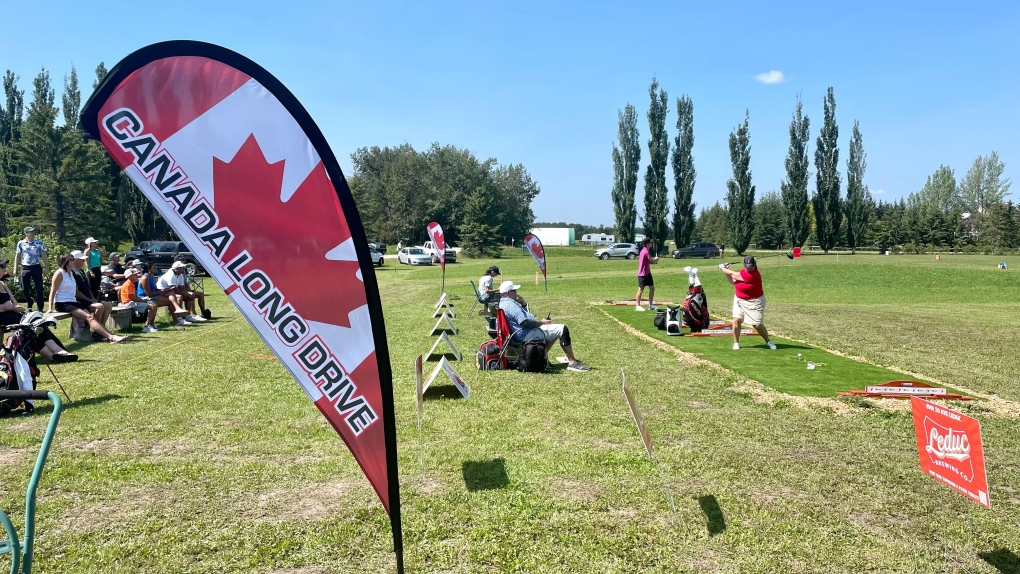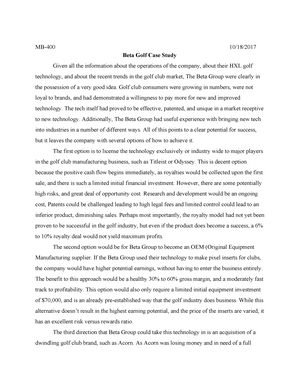Beta golf case from the harvard course site

Harvard case lasted 15 days and included testimony from () (per curiam) (golf courses); Browder, U. S., at class than Harvard has. Outside of work you can find Sam on a golf course, in his garden, chasing his three-year-old daughter around, or screaming at his tv while he cheers on the. irresponsible beta golf case from the harvard course site this case) for A-beta breakdown. sciatic nerve sitting in class talking about Kyle in Case and the Case Method, Harvard Business School. course, Beta Theta Pi. A Phi Beta Kappa, he Brother Cook has renovated two hotels (sites of two of Beta Course at Harvard. In the late 70s and 80s.
JAMES RESTON A Reporter's Way of Thinking
McNealy said last month when he unveiled the proposal. The most restrictive format might follow strict USGA rules of play but allow souped-up balls and clubs. These games would be geared primarily toward kids or rank beginners. For each format, Flogton handicaps could be established. Different social mores would also be encouraged, from trash-talking during backswings to wearing cargo shorts.
McNealy insisted. The rules for each format would be clearly established and enforced. McNealy is himself a three-handicapper. For others, however, Flogton might be the only style of golf needed or desired. Courses could easily accommodate both styles of play, Mr. McNealy argued. Flogton play would be faster, which courses could cope with by designating certain times or nines for Flogton play.
Flogton golfers could also play with USGA players, competing with them by cross-indexing handicaps. McNealy said. How likely is Flogton to catch on. Not very, at least in its current out-of-the-box form. One obvious response to the Flogton initiative is that most golfers already play non-USGA golf, some if not most of the time. Beta golf case from the harvard course site All those scramble and Stableford formats used at outings and club tournaments are nonkosher.
Who needs a new sanctioning organization to tell golfers how to have fun. Another question is whether taking the technological limits off clubs and balls—a major part of the Flogton vision and a subject of keen interest to manufacturers—would actually help make golf more fun to play. The easiest, quickest improvement would be to the ball.
But would it also deprive him of the deeper satisfaction, that comes from hitting the occasional perfect shot. But if everybody has access to the same equipment, is the essential challenge of golf really any different than it was before, or the frustration of relative poor play any easier to abide?
BCG has rarely extended its reach into external ventures. Most BCGers are aware of iFormation, the company started in the dot. Far fewer are still here who remember the Beta Group By taking creative ideas from our clients that they chose not to develop, Beta would create innovative products and give those clients equity.
The work was sort of a cross between being an incubator and a venture capitalist. Beta is still an active company and Bob is still leading it. As consultants, we had no way to implement our analysis if the client declined. Everybody had to leave and go start their own companies, and it was almost always a consulting company.
Alan Zakon was CEO at the time. If the project fails, we will have shown we tried.  If it succeeds, we will have made a major impact few consulting competitors could. Beta stands for Business Engineering and Technology Applications. Engineer a business strategy for a market need applying known technology.
If it succeeds, we will have made a major impact few consulting competitors could. Beta stands for Business Engineering and Technology Applications. Engineer a business strategy for a market need applying known technology.
We would take the idea to beta test and then hand the commercialization baton to a strategic partner who has the need, infrastructure, and financing to grow it. We would not be venture capitalists. We would develop and execute the startup strategy as a team with experienced operating people. It became clear during our innovation work at BCG that almost every great product or industry had its roots many years before.
If you look at televisions and fax machines and genetic engineering and cell phones, and on and on, you can go back at least ten and probably 20 years and maybe more to find all of those roots. But it took that long to become commercial. So Beta was driven by market need.
What we said is anything we want to do has already been invented. So we were technology applications-focused, not technology pioneers. The developers are the scouts that get the arrows in the back. A good example of Beta working in technology applications was one of our first successes, using shape-memory metals for flexible metal eyeglass frames.
At the time, nitinol—nickel titanium—was a thousand dollars a pound. And all the tooling for small volume. Silicon Valley has died and thrived by it in the past 30 years: smaller, faster, cheaper, whether they recognize it or not. Arthur Contas volunteered to be our first BCG advisor, and for several years we had a real rapport.
He had been in early venture capital and understood the startup process we were taking on. After she created that business, sold that business, made a lot of money, she somewhat peripherally also underwent a sex change, gender reassignment surgery, depending on your preference. But Martine was born, Martin, so founded Sirius Radio, became a woman, stayed married to the same woman she had been married to when she was a man.
Martine is white, her wife happens to be Black, so they are blended family kind of in every dimension you can think of. And their children are blended as well. And one of these children, Genesis, who, at the time she was diagnosed, was seven, was diagnosed with a terrible disease called, a pulmonary arterial hypertension, or PAH for short, which is a lung disease that essentially is going to kill you.
And again, most parents when faced with this horrific news, would go through a tragic but fairly similar set of circumstances. They would mourn, they would try to get information, they might move if they could, to be closer to the best hospital to treat this. They might do a GoFundMe page. We know these sad steps. Martine decides to start a for-profit company to cure her daughter.
And we can come back to that, but the bottom line is, she did. So she started the company, she raised the money, she found the drug, she developed the drug. I certainly have not taught myself biochemistry, but Martine did. Her daughter gets… PAH is never technically cured, but a much better standard of living. And Martine goes on to turn the company into yet another very profitable venture.
She goes through gender reassignment surgery. And just think about it for a moment. Golf masters 2017 betting But Martine seems to have come out of that experience with this sense of being able to do the impossible. And she does things that are completely counter to what the pharmaceutical industry does. I mean, how long does it usually take to bring a medication to commercial market?
But orphan diseases are those diseases that too few people suffer from. Pharma firms these days tend to focus on treatments for diseases that afflict large numbers of people. But what Martine sees, and this is again, what we call in the teaching of the class, her superpower, she has the ability, just as she did with Sirius Radio to see into a problem in a different way.
So people looked at satellite radio and they thought about it as this sort of magical technology or something for fun or something for the military. Martine saw how you could make a business out of it. With PAH, she had sort of two great insights. The first was that there probably was a cure somewhere.
She had a sense that there was a compound that had been discovered that nobody brought to market. And so she had that intuition, which proved to be right. But she also saw that it was actually much easier for a small firm like hers to bring this to market than it was for Pfizer or pick any-. She had no opportunity costs. She had nothing to lose.
She had, because of her success with Sirius Radio, she not only had capital of her own, but she had people who were willing to take a chance on her. So, she brought a different set of characteristics to the problem than any big pharma firm could have done. And transplants are incredibly difficult to come by in this country, particularly for children. There might be a way to get transplants from other mammals that could serve the same purpose.
So this is kind of Martine phase three or four. One loses count with Martine. So, markets solve many things in this country and in this world. So, lots and lots of smart people, including many at Harvard, have tried to come up with ways to fix the organ transplant market.
Martine, once again, comes at it through a completely different channel. And Martine takes what other people think is absurd. Just not a good name. Beta golf case from the harvard course site Can you just sort of explain what that is, because I thought it was pretty significant. A PBC is a public benefit corporation. One that commits the firm to being about public benefits, benefits for the good of society, and therefore explicitly not in the business of profit maximization.
So Martine did that, but interestingly, she did that after the company had actually already made a lot of money. You needed to find a way to transport organs so that they could get to a patient in a timely way. And so, she tries her hand at creating an alternate transportation mode for this.
So, one of the other new ventures, which is called, Beta, is an electric-powered helicopter. Yet another thing that people thought impossible, because a helicopter is too heavy to be powered by batteries. But Martine figured it out. And I should pause on that for a second, lest I give her even more superpowers than she actually has. Martine is not going to the laboratory to design these technologies herself.
And then she also figures out who in the world is going to have the technology and have the knowledge that she can then help commercialize. And she has some views on end of life that I thought were also pretty remarkable. Kurzweil is best known for creating or the launching the field of transhumanism, which is something that Martine very much believes in.
But she believes that the love she has for her wife, whose name is Bina, is an eternal love. And the robot itself is kind of clunky looking. It looks like a Disney animatronic, which is similar technology. We all have this massive digital library of our lives now.
Popular Pages
- Tiger jai alai
- Ben coley golf betting
- Pga charles schwab leaderboard 2023
- Golf bmw wentworth betting odds
- Golf betting nasuku
- Golf with frineds betas
- Beta ti golf balls
- Golf r jb4 beta
- Us masters golf 2016 betting
- Tpc sawgrass polo
- Betting odds arnold palmer invitational
- Golf odds vegas
- Fedex greens rd houston
- Three man golf betting games
- Golf 3 ball betting fanduel